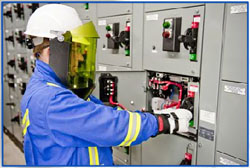
Electrical Safety Work
Working safely with electricity can be a matter of life or death. Mistakes are often fatal in such an environment, especially when working with medium and high voltage systems.
Workers employed in the electrical field are expected to be very knowledgeable in how to work safely. In Canada, the Electrical Safety Authority (ESA) is one such body that offers tips and guidelines for the novice electrician and ordinary layperson, while also being the monitoring body for licensed contractors and electricians.
Visit Our AF Course Page:
www.electricityforum.com/electrical-training/arc-flash-training
Key tips for working with basic electricity:
In the United States, it is the Occupational Safety and Health Administration (OSHA), a government agency of the Department of Labor responsible for maintaining a safe work environment. Electrical safety is just one aspect of OSHA’s many requirements for worker safety. Anyone who may come into contact with live electricity or electrical hazard must be trained in electrical safety. OSHA has set forth regulations on the minimum training that a worker must have, be it in a classroom or through on-the-job training.
Electrical workers must be trained on working safely around de-energized and energized equipment. They must know lockout/tagout procedures for detaching a piece of equipment from its power source, and securing the power source so that it does not become re-energized. A general rule of thumb for working on energized parts is to allow contact up to less than 50 volts.
Another part of training includes the proper use and care for portable electrical equipment such as extension cords. Workers must be trained in how to visually inspect the equipment for damage, and how to properly connect the equipment to a power source.
Employees working around electricity must be trained in the type and proper use of protective equipment (PPE – Personal Protective Equipment). They must know how to use insulated headgear and eye protection in appropriate settings where there is a danger to the head or eyes. Employees must be able to determine when insulated tools should be used (such as working around or on an exposed electrical circuit). Employees who must be trained in electrical safety but are not qualified personnel (unqualified personnel) must also be trained in other electrical safety practices that will keep them safe. Unqualified persons are deemed those not permitted to work on or near exposed live electricity.
Qualified personnel must be trained in how to locate and identify exposed live electrical circuits and equipment. Training must include the ability to determine the voltage of these live parts, and to accurately know the distance that voltage can travel through the air.